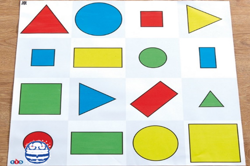Robots, data and computational thinking (Years 2-4)
This classroom resource comprises four worksheets to accompany a lesson on data and computational thinking. These materials are designed for teachers to use simple line-following robots (Ozobots) to engage students in the computational thinking process and working with data.
Additional details
| Year band(s) | 1-2, 3-4, Foundation |
|---|---|
| Content type | Lesson ideas |
| Format | Document |
| Core and overarching concepts | Computational thinking, Algorithms, Data acquisition, Data representation, Implementation (programming) |
| Australian Curriculum Digital Technologies code(s) |
AC9TDIFK02
Represent data as objects, pictures and symbols
AC9TDI2K02
Represent data as pictures, symbols, numbers and words
AC9TDI2P02
Follow and describe algorithms involving a sequence of steps, branching (decisions) and iteration (repetition)
AC9TDI4K03
Recognise different types of data and explore how the same data can be represented differently depending on the purpose
AC9TDI4P01
Define problems with given design criteria and by co-creating user stories
AC9TDI4P02
Follow and describe algorithms involving sequencing, comparison operators (branching) and iteration
AC9TDI4P04
Implement simple algorithms as visual programs involving control structures and input |
| Technologies & Programming Languages | Robotics and drones |
| Keywords | data, computational thinking, data collection, algorithms, data representation, implementation, robot, DTiF, dtif, DTIF, ACARA |
| Integrated, cross-curriculum, special needs | Numeracy, Digital Literacy |
| Organisation | Australian Government Department of Education and Training |
| Copyright | Australian Government Department of Education and Training, CC BY 4.0 |
Related resources
-

Computational Thinking Unplugged
This site provides a structured lesson plan with activities designed to promote computational thinking.
-

Makey Makey Projects for Years 4-6
These lesson ideas demonstrate how to combine Makey Makey together with Scratch to create all sorts of interesting solutions with students, as well as teach the basics of circuity, conductive materials and algorithms.
-

Blue-Bot challenges
Use these challenges created by Kylie Docherty, QSITE to provide opportunities for students to learn how to design and follow a series of steps to program Blue-Bot.
-

Bee Bot Balloon Pop
During this lesson, students will be required to consider the functions of the Bee-Bot and how a user can interact with this device.
-

CAS Barefoot
A broad collection of online resources to support teachers to develop and implement computational thinking, concepts and computer programming.
-

Coding in the Classroom
Through this website, educators can explore and share resources and strategies to teach coding.
-

Computing at School: Resources
Browse the curriculum resources which are tried and classroom tested resources submitted by primary teachers to support Computing for early to middle primary school.
-

Fairytale fun
Use the slide sorter function to arrange a set of presentation slides in correct sequence to retell a fairytale.
